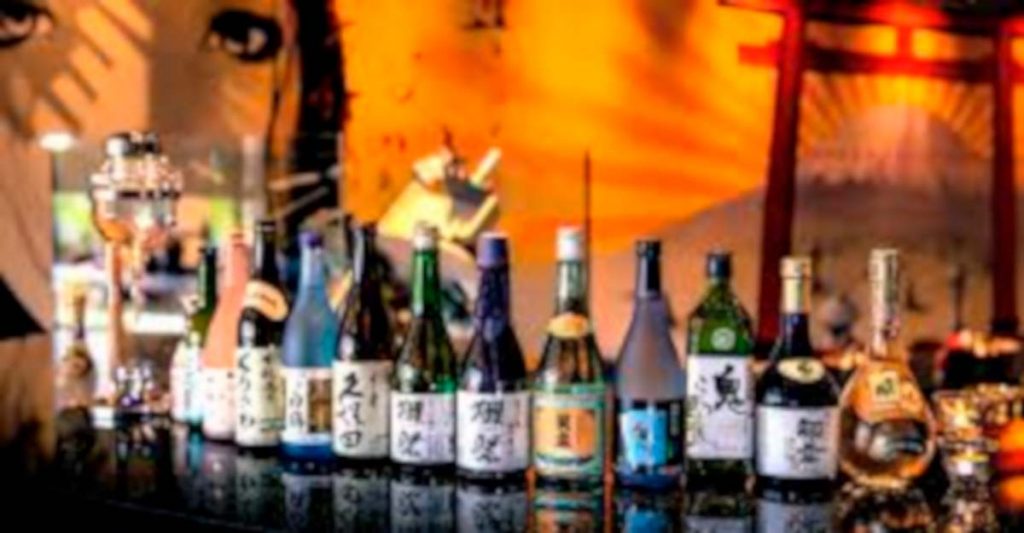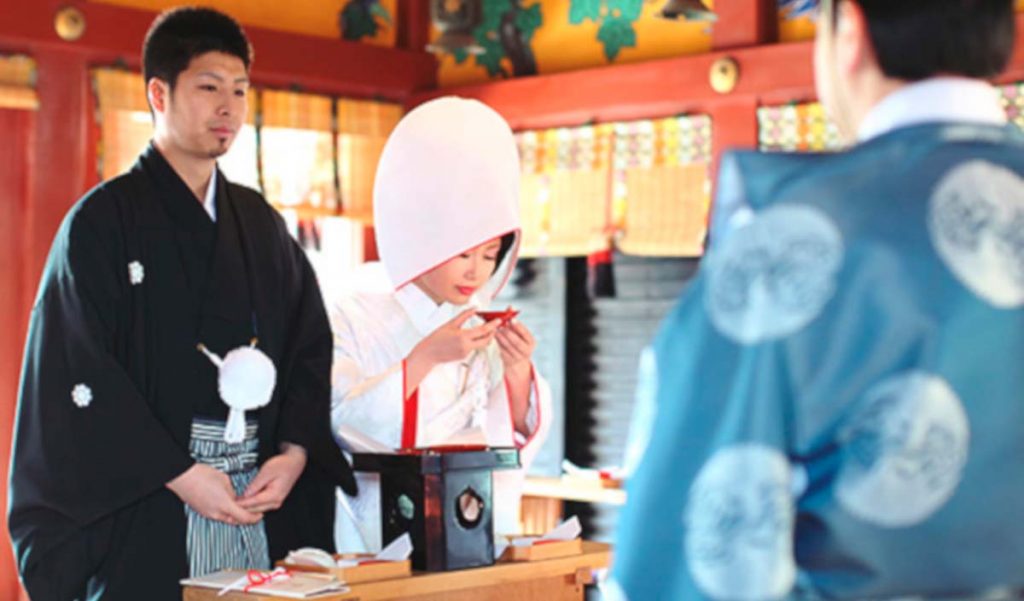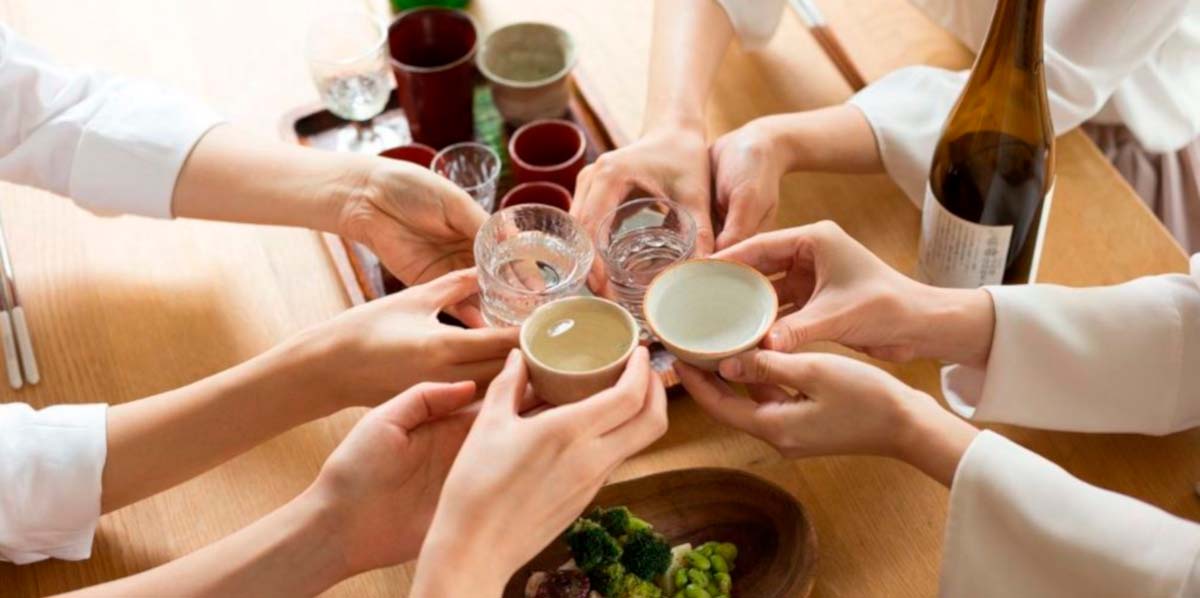Versione Italiana qui

Rather than saying wise things,
(Manyoshu, Collection of Ten Thousand Leaves)
it is better to drink sake
and shed tears of intoxication
The predilection of Japanese people for alcoholic beverages is certainly known, as also portrayed in several movies in which we have seen groups, people typically belonging to the same company, celebrate in some place with libations beyond abundance: it is the nominication, a neologism created by nomu, to drink, and from the English term communication, considered essential for connecting group members.
Beer is perhaps first in line among alcoholic beverages most preferred by Japanese people, closely followed by some products of winemaking and distillation, as whiskey, which in Japan has achieved world-class production excellence with local single malts.
But the alcoholic drink that is perhaps most immediately linked to this country is sake, or rather nihonshu, literally the spirit of Japan, which can be drunk hot or cold, called respectively atsukan or hiyashi.

Not only it is generally considered the iconic drink, but in Japan it sinks its fame up to the time when the Shinto gods descended on Earth for the most disparate reasons. According to one of these myths, Susanoo, son of Izanagi and brother of Amaterasu, the sun goddess from whom the Japanese emperors are traditionally descended, during one of these visits fought against an eight-headed and eight-tailed dragon, called Orochi, which was won with a sort of stratagem, as preparing eight tubs of sake then drunk by the dragon. When Susanoo finally cut it into pieces, in one of the tails he found Kusanagi no Tsurugi, the sword that together with the Yasakani no Magatama gem and the Yata no Kagami mirror, constitutes one of the three sacred treasures of Japan representing respectively the three virtues known as value, benevolence and wisdom, that finally became the Japanese imperial insignia since the seventh century.
Sake therefore plays a very important role in Japanese culture not only for the spirit that animates the great drinking happenings but rather for being linked to the legends of their gods.
This beverage has undergone numerous productive evolutions in its history. In around 700 AC, sake was used mainly for ceremonies and it was prepared in a particularly artisanal way. The forerunner of today’s sake, called kuchikamizake, sake chewed in the mouth, was in fact produced by exploiting the enzymes naturally present in saliva to convert the rice starch into sugar, in order to favor its fermentation. A particular version, exclusively used for ceremonial purposes with this particular production technique is known as bijinshu, the alcohol of beautiful women, as chewing was carried out only by young virgins, Shinto priestesses. This technique, disgusting as it may be nowadays, has continued for a long time in rural areas of the most remote islands of Japan, as well as among the Ainu population, the indigenous population of northern Japan. Fortunately enough, nowadays the action of saliva is replaced by the action of a mold called koji [1].
Throughout the different eras of Japanese history, the production of sake has been the prerogative first of the church, then of private families and companies, at alternate times, then of the shogunate, up to the present day, when production is regulated in some ways by Nihon Jozo Kyokai. , the so-called Brewing Society of Japan, simply because it is the official reference for the many yeast strains that can be used: there are sixteen of them, the differences of which are highlighted at the level of the final product (fruity rather than earthy, cereal rather than pear or dried mushrooms) but also in the production phase, depending on their better action based on the temperature of the geographical place of production.

Many producers use different yeasts, some of which are owned by the single producer rather than by a particular guild [1].
Sake is produced with the use of a few essential elements such as [1]
- rice, sakamai, a variety suitable for the production of the drink
- water, mizu, whose organoleptic characteristics greatly contribute to the quality of the finished product
- mold, kojikin, or more often simply called koji, which is Aspergillus oryzae, promoter of the production of the sugar substrate necessary for the proliferation of yeasts
- yeasts, kobo, mainly responsible for sake aroma and hints
Production method is really what makes the difference so to have different types of sake, method that although it includes common and mandatory steps, will guarantee the production of filtered or non-filtered, pasteurized or non-pasteurized, diluted or undiluted, aged or non-aged, and so on, also thanks to special optional and characteristic process steps. Among the non-mandatory operations, for example, the addition of alcohol to the product when it is still in the tanks, after filtration, is allowed in order to stabilize it and to modify its organoleptic appearance, based on the style of sake to be obtained, products then called aruten [1].
After fermentation, a solid mass, consisting of rice wastes, and a liquid part, which is already considered sake, even if raw and cloudy, are separated: the first then sake is obtained by pressing. Curiously, this phase is known with a term straddling the world of the sword (see The Kiryoku Glossary: Shibori, by Anna Rosolini), of the dyeing (see Shiboritsuki, lexical curiosity between sword and dye) and sake: it is the shibori phase, characteristic of the traditional pressing method alternative to the method without pressure known as fukurozuri, with which sake known as shiboritate is produced in the first instance (see Shiboritate, the first production of sake).
Finally, after pasteurisation, the aging phase follows, jukusei, which, due to the rapid oxidation of sake, must not be too long, at most six months, so that more characteristic and marked scents can mature than new sake Undiluted sake, called genshu, reaches a 20% alcohol content by volume and can therefore be diluted with water for more commercial use.

Until 1989 sake was classified into three categories based on how much the producer could afford to pay in classification fees, known as kyubetsu seido:
- Tokkyu, special category
- Ikkyu, first category
- Nikkyu, second category
Nowadays, however, the classification of this beverage has become rather complex and varied, as per Japanese categorisation habits, as it is based on the measurement of rice refining and constitutes a real qualitative pyramid of sake, although a more commercial classification is based on the production method, which provides characteristics derived from particular processes, so that sake is defined as:
- Genshu: sake produced without dilution process
- Nigorizake: unfiltered, with a milky appearance
- Kassei Nigori: fermented in the bottle, therefore without pasteurisation, a sparkling Nigori
- Orizake or Origarami: similar to Nigorizake but with finer particles, it is a rarer type of sake
- Namazake: sake that has undergone up to two pasteurisations
- Muroka Nama Genshu: literally unpasteurised, unfiltered and undiluted
- Happoshu: similar to Kassi Nigori, sparkling sake better known by the term Sparkling Sake, often called by its English name as it is not a product of the Japanese tradition, that can be produced by adding carbon dioxide
- Taruzake: aged in Japanese cedar barrels, taru
- Red Sake: obtained by using red rice, or by enrichment with red ash, or prepared with red koji or with red yeasts
- Jukuseishu and Koshi: aged sake, respectively up to three years and over three years, but generally no more than five
- Kijoshu: dessert sake (see Itadakimasu – Nihon Riori for Dummies: Rice and soy based desserts, by Cristina Gioanetti), often aged, more full-bodied, viscous and sweet
- Doburoku: ancient unfiltered sake from rural areas, the production of which was prohibited in the Meiji era (1868-1912). Since 2004, only the city of Tono has obtained the government concession for its production again
Finally, there are a good series of Seasonal Sake, whose classification is based on the time of maturation and therefore of placing on the market:
- Akiagari: produced in winter, matured until summer, marketed in autumn
- Hiyaoroshi: similar to Akiagari but without the second pasteurisation
- Shiboritate: sake obtained from the first pressing, very fresh and easy drinkable
- Shinshu: translatable as new sake, it is produced in the first two months of the year (the calendar year of the sake starts in June and ends the following May)
- Hatsushibori: the first sake of the year
- Kizake: translatable as live sake, it is not pasteurised so it keeps alive the enzymes present, very delicate, to be consumed entirely once opened
- Natsuzake: sake placed on the market in summer, natsu
With all these varieties and types of production, it is clear that sake has lost much of its original ceremonial value, even if it is still present for example in Shinto weddings. Today it is rarely served at large meals, but it still pairs with food alike wine, and sake-based cocktails have also become popular, such as Sake Rickey, Sake-tini, Sake Mojito, Svadka, and many others [3].

Aesthetics, as for any Japanese art and craft, is also important to allow one to be able to enjoy a good glass of sake. Typically sold in bottles, often very large, it is usually poured into small ceramic containers similar to small vases, generally called tokkuri, or from small and low containers more similar to our gravy boats, called katakuchi, or from bottles made in the shape of a pumpkin, hisago. From these small containers the sake is then poured for tasting in small glasses called choko, or guinomi if slightly larger, or in the characteristic box-shaped wooden glasses called masu, or in particular sakazuki saucers, often used in more formal ceremonies.
Sake can be served cold at around 10 ° C, then called reishu, at room temperature, or hot at around 50 ° C, then called atsukan, depending on personal preferences, ont the type of sake and on the season when it is served. The aksukan is heated after being poured into a tokkuri and placed in a bain-marie in a special metal container, called chirori, in the shape of a jug with a specially designed handle to be easily attached to the pot in which it will be heated in a bain-marie.

Not only typical of the art of the sword, the rules of etiquette or the Reiho (see The Kiryoku Glossary: Reiho, by Anna Rosolini) constitute a fundamental aspect of culture Japanese, and therefore do not fail to characterize even the simple conviviality of a pleasant drink in company, as the aforementioned nominication, based on slightly more severe habits and customs, or a simple consideration on less formal occasions but not because of this reason less meaningful.
Let’s then remember then the following are considered good manners [2]
- Never pour drink yourself: in Japan, serving yourself a drink alone is frowned upon and can give a bad impression to those present, so you let someone else pour a drink into your glass and then you will return the pouring gesture, while in business dinners it is customary for subordinates to do it for their superiors
- Do not drink before others: it is considered rude, in Japan as in the rest of the world
- On the first round, everyone orders the same drink: usually a glass of beer, but this is not a rigid rule, so one is still free to order something different from the others
- Kanpai: every self-respecting drinking session begins with a nice toast, to the cry of kanpai, and it is customary to stand up so that you can toast even with the most distant people
- Do not drink from the bottle: in Japan it is quite rude. If you drink straight from the bottle, you break the rule of serving each other and because the drinks are meant to be shared, drinking from the bottle would give the impression that what your drink is just for yourself
Being able to enjoy a good sake at its best would include knowing how to read the complicated label glued to these bottles and that provides all the details about production, classification, type of service, temperature, acidity, alcohol content, density and a thousand other values to better define the product and how to taste it. To take advantage of more understandable labels and descriptions, between evolution, experimentation and globalization, we could instead approach the production of our own sake: on the other hand, Italy is a strong rice exporting country, even if not traditionally destined for fermentation products.
Companies such as Riso Sake have combined the ancient rice-growing tradition of Pavia with the Japanese tradition of nihonshu, or as the company Gli Aironi which started with the production of rice beer and subsequently moved on to the production of Italian sake, as the result of experimentation with black rice from Vercelli so to the create a particular dark non-transparent sake, which at first taste releases the typical aromas linked to brewing fermentation, first with fruity and then with spicy notes.
So, nothing remains if not pouring each other some sake into our choko, standing up and… kanpai!

lele bo
SOURCES
[1] Sake – Storia, Produzione, Curiosità – Guido M.Poggia
[2] https://gogonihon.com/it/blog/cultura-del-bere-in-giappone/
[3] https://www.esquire.com/it/lifestyle/food-e-drink/a20950541/sake-come-bere/











